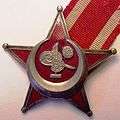Gallipoli Star

The Gallipolli Star is the name of two military decorations, one awarded by the Ottoman Empire, one proposed by the British Commonwealth never awarded but later privately struck. The Ottoman award was known as the Ottoman War Medal (Turkish: Harp Madalyası) or the Iron Crescent (from German Eiserner Halbmond, in allusion to the Iron Cross). It was instituted by the Sultan Mehmed Reshad V on 1 March 1915 for gallantry in battle. This decoration was awarded for the duration of World War I to Ottoman and other Central Powers troops, primarily in Ottoman areas of engagement.
Ottoman War Medal
Design and composition
The award includes a badge, ribbon and campaign bar.
The medal, made of nickel-plated brass, has a vaulted star-shaped badge, 56 mm across the diagonal span of the arms. The tips of the star are capped by ball finials and enclosed in a raised silver edge with the field in red lacquer or enamel. A raised crescent, open at the top, encircles the center of the badge. Inside the crescent is the tughra or cipher of the decoration's creator, Sultan Mehmed Reshad V, over the date 1333 AH (AD 1915). The reverse is flat, unadorned and has a straight pin.
Along with the badge came a ribbon with red and white stripes. The dimensions of the ribbon for combatants are: red 2.5 mm; white, 5 mm.; red, 29 mm.; white, 5 mm.; red 2.5 mm. For non-combatant awardees, the colors are reversed.
The campaign bar is a right-pointing parabola of white at 56mm in length and 7mm in height. In the field is red Arabic script denoting the specific campaign:
Wear
When in formal dress, the badge was worn at the center, below the right breast pocket. Wear of the badge was exclusive; in everyday wear was substituted by the ribbon. The ribbon was worn from the second hole in the tunic button.
For Austrian and German awardees (usually members of the Asienkorps), the award took lower precedence to their own Iron Cross 2nd class, and the ribbon of the Iron Crescent was placed beneath that of the Iron Cross.
The ribbon could also be fashioned into a chest riband for placement on a ribbon bar when in undress.
The campaign bar was usually not worn.
Commonwealth medal
The Commonwealth Gallipoli Star, originally to have been called the ANZAC Star, was proposed by Lieutenant General Birdwood for Australian and New Zealand troops who served at Gallipoli. Despite approval by George V, protest at a medal that could not be awarded to all Commonwealth troops was raised by British parliamentarians and media. In 1918, after ribbons, but not medals, had been shipped to the two nations, the award was cancelled and instead eligible soldiers were awarded the 1914 – 1915 Star.[1] In 1990 the award was privately struck with 200 copies being given to Gallipoli veterans and the other 1800 sold to collectors.
Design
The medal was designed by R K Peacock. It was an eight-pointed bronze star (represented NZ and the seven territories of Australia) surrounding a silver disc. On the disc the words "Gallipoli 1914-15" surrounded the King's crown.[2]
The ribbon had a blue centre with yellow on the wearer's right and silver (white) on the left. Between the yellow and blue and between the blue and white there was a narrow stripe of red. Yellow represented the Australian wattle, white the NZ silver fern, blue the ocean and red for the Australian gum blossom and NZ rata.[2]
References
- ↑ "NZDF Medals - The 1914 - 15 Star". medals.nzdf.mil.nz. Retrieved 2016-04-30.
- 1 2 "Specimen Gallipoli Star : R E Smith". Australian War Memorial. Retrieved 2016-04-30.
- Klietmann, Dr. Kurt-Gerhard, (1971): Deutsche Auszeichnungen: Ein Geschichte der Ehrenzeichen und Medaillen, Erinnerungs- und Verdienstabzeichen des Deutschen Reiches, der deutschen Staaten sowie staatlicher Dienststellen, Organisationen, Verbande usw. Vom 18. - 20. Jahrhundert. 2 Band. Deutsches Reich 1871- 1945. Berlin: Ordenssammlung.
- ERMAN, M.Demir, (2012) Harp Madalyası - The Turkish War Medal - ISBN 978-605-125-484-5 - http://demirerman.wix.com/turkish-war-medal
Gallery
-

Gallipoli Star badge with ribbon
-

Gallipoli Star riband
-

Gallipoli Star - Turkish manufacture
-

Gallipoli Star - Turkish manufacture
-

Gallipoli Star badge - B.B. & Co.
-

Gallipoli Star badge - Godet
-

Gallipoli Star badge - J.H. Werner